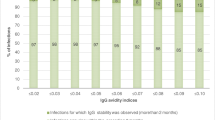Summary
The total rubella IgG antibody avidity ELISA, as described byHedmann [8] for differentiation between acute primary rubella and reinfection, persisting or non-specific IgM antibodies were evaluated in 212 sera of four categories of patients with known history (n=149) and in one group (n=39) of patients with a history of unclear nature. The development of the IgG ratio (avidity) from low (<30%) to higher levels (>30%) was determined in 146 sera from 96 cases with acute primary rubella between days 1 to 256 after onset of exanthem, with a borderline between low (<30%) and high (>30%) avidity after four weeks after onset of exanthem. From seven days to 14 years following vaccination, the IgG ratio increased more slowly following vaccination, with a useful borderline at 2 1/2 months. In 80 sera from 13 women with reinfection during pregnancy, six infants with rubella embryopathy, and 19 pregnant women with rubella IgM antibodies detected during antenatal screening, the total IgG ratio ranged between 48% and 100%, indicating a previous infection. The diagnostic value of the IgG subclass-specific antibody avidity assay was investigated in 40 of the 251 sera. The results confirmed those of the total IgG avidity assay. Both tests are of additional help for differentiating serologically primary rubella from reinfection or recent from previous vaccination.
Zusammenfassung
Der Avidity-ELISA für Röteln-Gesamt-IgG [8] zur Differenzierung von akuten primären Röteln, Röteln-Reinfektion, persistierenden oder nichtspezifischen IgM-Antikörpern für die Diagnose von Rötelnproblemfällen wurde anhand von 212 Seren von vier Kategorien untersucht. Die Entwicklung der IgG-Ratio (avidity) von niedrigen (<30%) zu höheren (>30%) Werten wurde mit 146 Seren von 96 Fällen mit akuten primären Röteln entnommen zwischen 1 und 256 Tagen nach Ausbruch des Rötelnexanthems bestimmt. Die Grenze zwischen niedrigen (<30%) und hohen Ratios (>30%) lag bei vier Wochen nach Exanthembeginn. In 32 Seren von 23 Impflingen mit Serumentnahme zwischen sieben Tagen und 14 Jahren nach Impfung stiegen die IgG-Ratios langsamer an, mit einer nützlichen Grenze bei 2 1/2 Monaten. In 80 Seren von 13 schwangeren Frauen mit Reinfektion während der Schwangerschaft, sechs Kindern mit Rötelnembryopathie und 19 Schwangeren mit IgM-Antikörperbefunden bei Untersuchung in der Mutterschaftsvorsorge bewegte sich die IgG-Ratio zwischen 48% und 100% als Hinweis auf frühere Infektion. Der diagnostische Wert des IgG-Subklassen-spezifischen Avidity-Assays wurde anhand von 40 der 251 untersuchten Seren bestimmt. Dessen Ergebnisse bestätigten die Befunde mit dem Gesamt-IgG-Antikörper-Avidity-Assay. Beide Teste geben eine zusätzliche Absicherung für die serologische Differenzierung von primärer akuter Infektion und Reinfektion bzw. von kürzlicher zu früherer Impfung.
Similar content being viewed by others
References
Linde, A. Subclass distribution of rubella virus-specific immunoglobulin G. J. Clin. Microbiol. 21 (1985) 117–121.
Thomas, H. I. J., Morgan-Capner, P. Rubella-specific IgG subclass avidity ELISA and its role in the differentiation between primary rubella and rubella reinfection. Epidemiol. Infect. 101 (1988) 591–598.
Thomas, H. I. J., Morgan-Capner, P. Rubella-specific IgG subclass concentrations in sera using an enzyme-linked immunosorbent assay (ELISA): the effect of different sources of rubella antigen. Epidemiol. Infect. 101 (1988) 599–604.
Morgan-Capner, P., Thomas, H. I. J. Serological distinction between primary rubella and reinfection. Lancet I (1988) 1397.
Devey, M. E., Bleasdale, K., Lee, S., Rath, S. Determination of the functional affinity of IgG1 and IgG4 antibodies to tetanus toxoid by isotype-specific solid-phase assays. J. Immunol. Meth. 106 (1988) 119–125.
Inouye, S., Hasegawa, A., Matsuno, S., Katow, S. Changes in antibody avidity after virus infections: detection by an immunosorbent assay in which a mild protein-denaturing agent is employed. J. Clin. Microbiol. 20 (1984) 525–529.
Rousseau, S., Hedman, K. Rubella infection and reinfection distinguished by avidity of IgG. Lancet I (1988) 1018–1019.
Hedmann, K., SeppĂlĂ, I. Recent rubella virus infection indicated by a low avidity of specific IgG. J. Clin. Immunol. 8 (1988) 214–221.
Enders, G., Knotek, F. Detection of IgM antibodies against rubella virus: Comparison of two indirect ELISAs and an anti-IgM Capture Immunoassay. J. med. Virol. 19 (1986) 377–386.
Enders, G., Knotek, F., Pacher, U. Comparison of various serological methods and diagnostic kits for the detection of acute, recent, and previous rubella infection, vaccination, and congenital infections, J. Med. Virol. 16 (1985) 219–232.
Thomas, H. I. J., Morgan-Capner, P. Specific IgG subclass antibody in rubella virus infections. Epidemiol. Infect. 100 (1988) 443–454.
Author information
Authors and Affiliations
Rights and permissions
About this article
Cite this article
Enders, G., Knotek, F. Rubella IgG total antibody avidity and IgG subclass-specific antibody avidity assay and their role in the differentiation between primary rubella and rubella reinfection. Infection 17, 218–226 (1989). https://doi.org/10.1007/BF01639523
Received:
Accepted:
Issue Date:
DOI: https://doi.org/10.1007/BF01639523




